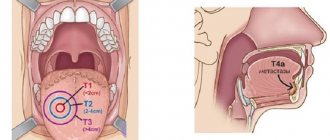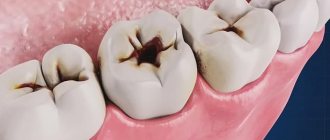Tongue cancer is a fairly rare disease, but despite this, more and more cases of this pathology are registered every year. The most important thing is to pay attention to the early signs when a tumor appears; besides, it is quite difficult to miss. It should be noted that most often males suffer from tongue cancer, while women are least affected by this disease. What are the symptoms of tongue cancer?
Causes of tongue cancer
The symptoms of tongue cancer cannot be confused with anything!
Tongue cancer, like any other form of malignant tumor, appears for a reason. Its appearance is preceded by many factors that provoke cell mutation. The main causes of tongue cancer include:
- Excessive smoking. But in some cases, even smokers with little experience may develop a tumor. This is due to the individual characteristics of the body and the structure of the mucous membrane
- Chewing nicotine gum, which is used by people if they want to get rid of a bad habit.
- Chewing tobacco, which irritates and damages the mucous membranes
- Excessive consumption of alcoholic beverages
- Heredity. Many people know that if someone in their family had one or another cancer disease, then their descendants are at risk
- Serious diseases that can provoke a decrease in the body’s defenses, that is, immunity
- Papilloma virus. Scientists attribute an increase in the number of cases of patients with tongue cancer to this reason. This is because people are engaging in oral sex more often. And, as you know, papilloma is transmitted both sexually and oral
- Inflammation of the gums that remains untreated for a long period of time
- Poor dental condition
Despite the fact that almost everyone knows about the main causes of tongue cancer, few people pay attention to them. And therefore, every year the number of people with this disease, which is not so easy to treat, is growing.
Diet
Diet for tongue cancer
- Efficacy: therapeutic effect for a month
- Timing: constantly
- Cost of products: 1300-1500 rubles per week
Difficulties with swallowing in the patient before and after surgery force the installation of a nasoesophageal tube. Through it, broth with meat and eggs beaten in a blender, sour cream, cream and other high-calorie liquid products are introduced. A nutritional mixture must be prescribed in addition to the main diet . This is a liquid high-calorie and high-protein mixture enriched with micronutrients. This can be Nutrizon Advance , Nutrizon Protein Advance , Nutrizon Energy , Nutrizon Protein Intense , Supportan Mixture for enteral nutrition, Fresubin original , Fresubin Energy , Nutricomp . With the transition to natural nutrition, a diet table with liquid dishes is organized - puree soup, boiled fish and meat (veal), poultry (turkey, chicken), whipped in a blender, meat and fish soufflé, liquid omelet, yoghurt, milk, cauliflower, broccoli in the form of mashed potatoes, mashed potatoes.
Precancerous conditions
We should also talk about those diseases that are classified as precancerous conditions. It is they who need to pay more attention and treatment, since any factor can provoke the degeneration of simple cells into cancerous ones. Such diseases include:
- Leukoplakia. This is keratinization of the mucous membrane in the mouth, most often a red stripe appears on the lips. The main reason for the appearance of this disease is a decrease in the stability of the mucous membrane in the gastrointestinal tract, which leads to the penetration of harmful microbes and viruses into it, which can provoke cell mutation
- Papilloma. This is a benign formation, which consists of papillary growths of connective tissue. In themselves, such formations are painless, but they pose a great danger associated with the possibility of the tumor degenerating from benign to malignant
- Ulcer. It often happens that a person damages the oral mucosa. This can occur as a result of biting the cheek, tongue, cut, or thermal burn. In the event that no antibacterial treatment is carried out, the likelihood of ulcers on the mucous membrane increases, and as a result, in the future, the formation of cancer cells
- Glossitis. This is a very rare disease, but still encountered in medical practice, which is characterized by pain in the tongue, as well as increased salivation.
- Bowen's disease. This disease is characterized by the appearance of a small spot on the tongue, which has a rough surface. Over time, erosion may appear on it
If a patient is diagnosed with one of the above diseases, then close attention is paid to its course, as well as treatment. Due to the fact that some of these diseases cannot be completely cured, a person is recommended to visit a specialist every six months or year for a full examination and examination in order to control the situation.
Symptoms of tongue cancer
Papillomas can cause cancer
Tongue cancer is one of the diseases whose symptoms are so vivid that they force a person to independently seek medical help from a specialist. The main symptoms of tongue cancer include:
- The appearance of plaque or spots on the tongue itself. The spots and amount of plaque may vary for each person, as it depends on what stage of cancer, where in the tongue it is located, etc.
- The appearance of ulcers on the tongue
- The appearance of a small lump on the surface of the tongue, which indicates that the person has the first stage of tongue cancer
- Painful sensations that primarily appear at the site of the tumor. But sometimes the pain can radiate to the jaw, throat, ear or nose. Very often, pain intensifies when a person eats food, especially solid food.
- Bad breath, which occurs due to the presence of cancer cells in the mouth
- Inflammation of nearby lymph nodes. One of the most obvious signs of any cancer is enlarged lymph nodes. This pathology is characterized by enlargement of the cervical and submandibular lymph nodes. Separately, it is worth saying that not one node will be enlarged, but the entire group at once, which should alert any person
- Increased production of saliva, which has nothing to do with food intake or hunger
Depending on where the tumor is located on the tongue, certain symptoms will be more pronounced, or, conversely, more blurred.
It is customary to distinguish several options for the location of the tumor:
- At the root of the tongue
- On the side surface. Most cases occur in this location of the tumor
- On the bottom surface
- On the top surface
The symptoms of tongue cancer cannot be confused with almost anything. In addition, discomfort in this area is noticed almost immediately, since the resulting tumor interferes with normal eating, and sometimes can even interfere with conversation.
Stages of the disease
Stages of tongue cancer
We offer you a table of correspondence between tongue tumor stages and clinical TNM classification, which uses the following designations:
- T – indicates the primary tumor: Tx – the primary tumor cannot be assessed;
- T0 – no data on the primary tumor;
- Тis – cancer in situ (pre-invasive stage);
- T1-T4 – the primary tumor is enlarged and/or widespread.
- Nx – regional lymph nodes cannot be assessed;
- M0 – no distant metastases;
Correspondence table for stages of tongue cancer TNM classification
| TNM stage | |
| 0 (carcinoma in situ) | Tis, N0, M0 |
| I | T1, N0, M0 |
| II | T2, N0, M0 |
| III | T3, N0, M0 or T1-T3, N1, M0 |
| IV | 4a: T4a, N0 M0 or T4aN1, M0 or T1-T4a, N2, M0 4b: T4b, any N, M0 or any T, N3, M0 4c: any T, any N, M1 |
Periods of development of cancerous tumors
Tongue cancer develops very rapidly. That is why it is customary to distinguish several forms and periods, each of which will be characterized by its own symptoms of manifestation. It is customary to distinguish three periods of tongue tumor development:
- Elementary. At this stage, the person begins to notice that a seal has appeared on the tongue, which causes him discomfort. After a short period of time, the tissue in this place becomes more and more dense, and white spots also appear. On top of everything else, there are also pain sensations that spread not only to the site of the tumor, but can also radiate to the throat, nose or ears. True, some patients associate pain with caries or sore throat. In the initial period, three forms of tumor can be distinguished, differing in anatomical characteristics:
- Ulcerative. A lump appears that eventually develops into an ulcer
- Knotty. The seal that has appeared has a whitish tint and is also very dense to the touch. In addition, there are clear boundaries of education
- Papillary. Growths appear that are very similar to papillomas. Only if the papilloma itself is not hard, then the papillary tumor is very hard
- Developed. During this period, all symptoms begin to worsen, and the person suffers from severe pain. In most cases, the pain becomes so severe that even painkillers do not help the patient. In addition, the pain is localized not only in the tongue, but also spreads to the throat.
Also, during an acute pain attack it radiates to the ear or nose. It is during this period that bad breath appears, which is caused by the breakdown of cancer cells. In the developed period, it is customary to distinguish two forms of tumor:
- Exophytic. Ulcers increase in size slightly
- Endophytic. The ulcers deepen and become very large
- Neglect. During this period, the cancer spreads so quickly that the tissue begins to break down, the tumor increases in size, and the symptoms become very vivid.
As mentioned above, each period is characterized by its own course and symptoms. They manifest themselves most clearly in the second period, and already force any person, even those who do not take them seriously, to consult a specialist to find out the cause.
Kinds
In 70% of cases, cancer of the body of the tongue is detected, in 20% - damage to the root, and in 10% - to the lower surface of the organ. If we divide diseases according to cell characteristics, we can distinguish the following forms:
- Papillary. It looks like a dense growth with papillary outgrowths and plaque-like formations.
- Ulcerative. It is observed in approximately 50% of cases. Ulcers develop over time, can bleed, and often become infected, thereby masking the root cause of the disease.
- Infiltrative. Cancer grows inside the tongue and hardens its tissues. The form can be diffuse or spread throughout the entire organ.
If we talk about microscopic analysis, then in 95% of cases we are talking about a squamous cell form of tongue cancer, other options are much less common.
Diagnostics
The tongue needs proper care
After the patient has contacted the doctor with complaints, he will be prescribed an examination, during which the following procedures will be carried out:
- Interview, identification of chief complaints, and manual examination of the tongue and neck area
- Referral for basic tests
- Biopsy of organ cells
- Ultrasound examination of the tongue and neck, as well as some abdominal organs
- X-ray of the lower jaw, as well as all organs located in the chest
- Lymph node puncture
- Computed tomography or magnetic resonance imaging
After all the examination results have been received, the doctor will be able to make an accurate diagnosis and prescribe the correct treatment.
List of sources
- Alieva. S.B., Alymov Yu.V., Kropotov M.A., Mudunov A.M., Podvyaznikov S.O. Cancer of the oral mucosa. Oncology. Clinical recommendations / Ed. M. I. Davydova. – M.: Publishing group RONC, 2015, pp. 27-37.
- Romanov, I.S. Features of regional metastasis of squamous cell carcinoma of the oral cavity, detected during preventive lymph node dissections. / Romanov, I.S., Yakovleva L.P., Udintsov D.B., Dzhumaev M.G., Tsiklauri V.T. // Dentistry. – 2012. – T.91, No. 4. — P. 28-31.
- Romanov I. S., Yakovleva L. P. Issues in the treatment of oral cancer. Farmateka 2013; (8):59–63.
- Paches A.I. Tumors of the head and neck. 5th ed., supplemented and revised M.: Practical Medicine, 2013. P. 119‒146.
- Romanov I. S. Prospects for the use of cetuximab in the treatment of squamous cell carcinoma of the head and neck / Oncology. Hematology. Chemotherapy. - 2015. - No. 17/1.
Treatment of the disease
The success of the chosen treatment depends on the stage at which tongue cancer was detected. Based on this, as well as on the individual characteristics of the person, treatment will be selected that will help reduce the tumor or get rid of it altogether. After the results of tests and all examinations have been received, and the alleged diagnosis has been confirmed, the patient will immediately be sent to an oncologist, who will begin treatment. Typically, three methods are used:
- Surgical intervention. Depending on the size of the tumor, one or another method of surgical intervention will be chosen:
- If there are many lesions or the tumor is very large, the person may undergo a glossectomy, that is, removal of the entire tongue or most of it.
- In the event that it is possible not to remove everything completely, then partial resection is performed, and in some cases the person retains the ability to speak.
- If the tumor has already affected other tissues, then those areas in which cancer cells are present can be removed. Sometimes partial resection of the tissues of the floor of the mouth or jaw may be necessary, as well as removal of the affected lymph nodes
- Chemotherapy. Chemotherapy is the introduction of special drugs into the human body, the action of which is aimed at destroying cancer cells. Most often, chemotherapy is prescribed in cases where it is necessary to reduce the tumor to an operable size, as well as in the presence of metastases to other organs. Today, polychemotherapy has become especially popular, the effectiveness of which ranges from 50 to 70 percent (if we talk about standard monochemotherapy, its effectiveness is no more than 30 percent). A combination of drugs such as fluorouracil and platinum-based drugs is used here. Thanks to the unusual combination, the highest effect is achieved. And in the simplest cases, only one or two sessions of such chemotherapy are required. Chemotherapy is also given after surgery to kill remaining cells and reduce the risk of relapse.
- Radiation therapy. It is used both as an independent treatment and as a combined treatment. For the first procedure, average values are selected, that is, when the total focal dose reaches 35 or 40. If after the first session there is no noticeable improvement or there is, but insignificant, then radiation therapy is completed and another treatment method is chosen. If at this dose the tumor has decreased by 50 percent, then radiation therapy is continued until there is significant improvement, and the total focal dose is increased to 60.
Under no circumstances should you ignore the advice and recommendations of an oncologist and try to treat cancer yourself. Many people believe that traditional medicine will help them. Unfortunately, in this case it is powerless, since it cannot have the effect on cancer cells that is required. In addition, treatment with folk remedies is not aggressive. And this is how you need to approach cancer.
Forecast
With early diagnosis and radical treatment, the prognosis for recovery from tongue cancer is more favorable. It is believed that complete recovery from cancer is impossible and the goal of treatment is to achieve long-term remission of 5-8 years. Thus, with this pathology, the five-year survival rate ranges from 65 to 85%. Complete remission within 5 years after surgery and radiation therapy with T1 is achieved in 80% of patients, with T2 in 60% of patients, and with T3-4 does not exceed 35%. Metastases in the lymph nodes are an important prognostic factor and, if present, survival rate is halved.
How long do people live with stage 4 tongue cancer or with relapse after chemotherapy? Such patients have a poor prognosis: they live no more than 3.5 months while on maintenance treatment. The addition of cetuximab to chemotherapy increases survival by 2 times.
Tongue root cancer
You should pay attention to even the slightest changes
This is one of the most difficult types of cancer, since the location of the tumor does not allow it to be removed without causing great harm to the person. In most cases, after cancer of the root of the tongue, that is, after treatment, a person loses the ability to speak, and his quality of life noticeably decreases.
Cancer of the root of the tongue is also dangerous because symptoms begin to appear only 2 or 3 months after the tumor has formed. In addition, a person cannot independently see any changes occurring at the root of the tongue, and therefore only a doctor can make a diagnosis or detect the problem. As for the symptoms of tongue cancer in later stages, these include:
Prevention and prognosis
The main goal of prevention against tongue cancer is to give up bad habits such as smoking and alcohol. Chronic injury to the mucous membrane of the tongue should also be avoided, including timely treatment of chipped teeth, high-quality treatment of fillings, and proper installation of dentures.
Be sure to visit your dentist regularly to have your mouth examined and look for any changes. With timely diagnosis, the prognosis for recovery is more expected. With timely treatment, life expectancy, according to research, ranges from 5 to 15 years.
Survival prognosis
Each type of cancer has its own prognosis, but it can be roughly represented as follows:
- If a cancerous tumor is detected at the first or second stage, the survival rate is 75 percent
- If a cancerous tumor is detected at the third stage, the survival rate is 50 percent
- When a cancerous tumor is detected at the fourth stage, the survival prognosis is less than 30 percent. It should be noted that a period of time equal to five years is taken.
Those who promptly consult a doctor for medical help have every chance of recovery, since the earlier tongue cancer was detected, the easier it will be to cure.
Tongue cancer is one of the most dangerous diseases that develops rapidly. That is why, if you detect at least a few symptoms indicating cancer, you should not immediately contact a specialist in order to avoid the possible transition of the disease to the most severe stage.











